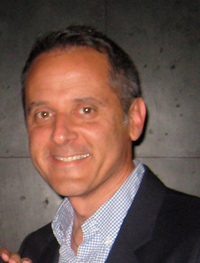Thyroid Cancer Survivor
Survivor proves there is no typical patient
 Bob Legler was diagnosed with Stage IV thyroid cancer but insisted on beating the odds.
Bob Legler was diagnosed with Stage IV thyroid cancer but insisted on beating the odds.
I am proof that statistics and textbooks don’t call the shots. Doctors gave me less than a 1-percent chance of making it to my 44th birthday, and guess what? I’m 51.
My story starts in 2003, two weeks after returning from spring break with my family. That’s when I first noticed a small lump on my neck. I was in the best physical condition of my life – running, playing tennis and working out were part of my daily routine – so I wasn’t too concerned. I didn’t smoke and I ate a healthy diet. I was in damn good shape for a 43-year-old man.
I thought the bump was a bug bite or possibly a muscle pull, but when I started having difficulty buttoning the top button of my dress shirts, I made an appointment to get it checked out. My doctor said the bump looked to be pulsing and sent me for a CT scan, which detected a mass. He referred me to an ENT, who suspected that I had thyroid cancer and pushed for immediate surgery to remove the mass.
All I have to say is thank God for that ENT. When she opened me up, she found that the mass had tripled to a grapefruit-sized tumor and was now behind my sternum and wrapped around my trachea and voice box. I learned I had Stage IV anaplastic thyroid cancer and had only 90 days to live—not a good prognosis for a dad with a 14-year-old son.
I wasn’t ready to give up, so I got in touch with an old friend who helped me get an appointment with a leading oncologist, who was an expert on thyroid cancers.
Although he had never treated a successful case of ATC, this doctor agreed to help me but warned that there was less than a 1-percent chance of survival beyond the 90-day time frame. He also told me there was no reason that I couldn’t be part of that 1 percent. He gave me hope.
For two and a half months, I had radiation, chemotherapy and drug treatments, and amazingly I am alive and well with a new mission in life. I’m here to tell everyone that although text books and research studies are important in teaching doctors about diseases and treatments, hospitals are full of people who are not statistics and textbooks. Thus, no case is really “textbook.” You might be less than 1 percent in a textbook somewhere, but in my life it was 0 or 100 percent, and I am so glad that my doctors gave me the chance to be 100 percent.


